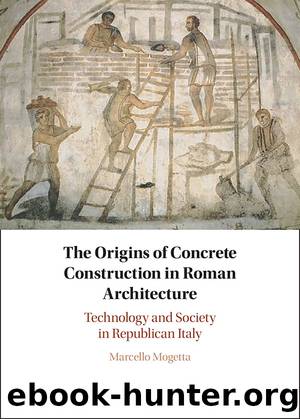The Origins of Concrete Construction in Roman Architecture by Mogetta Marcello

Author:Mogetta, Marcello
Language: eng
Format: epub
Publisher: Cambridge University Press
Published: 2021-05-28T00:00:00+00:00
Pompeian Concrete Construction in Its Regional Context
The discovery of such simultaneous and convergent developments at Rome and Pompeii brings us back to our starting point, raising the question of whether direct Roman influence lies behind the introduction of concrete to Campania. The issue can now be tackled in a more pragmatic fashion, challenging past ideas that saw the refinement of the technology, its large-scale application, and the rationalization of the building process as advances brought about by Roman presence in the region. Roman builders were hardly ever involved in the construction of the aristocratic concrete houses of Pre-Roman Pompeii. The design of the Casa di Pansa, one of the key sites for the dating of the early development of the technique, was based on the Oscan foot,190 thereby suggesting that local specialists were in charge. Although it is possible that Pompeian masons learned of the new technique as this was being introduced at Rome, it is unlikely that they were adopting it so as to imitate the way of doing things seen in Romeâs aristocratic residences. The fact that important features of the earliest concrete houses at Rome (e.g., the use of opus quadratum on top of the mortared rubble foundations, even for interior partitions) do not appear in the Pompeian examples undermines ideas of diffusion centered on the metropolis. On the contrary, it has often been remarked how the local architects and builders working for the wealthy Samnite patrons who commissioned the new houses produced quite an original class of monuments. The reason for this has been sought in the greater degree of political and ideological âfreedomâ that the Pompeian elites enjoyed in the reception and display of Hellenistic luxury than their Roman counterparts had.191 According to this perspective, it was away from the metropolis, in their villas on the Bay of Naples, that Roman senators could embrace those models on a grander scale.192 It is indeed plausible that Romans themselves developed their technology by experimenting with the highly reactive materials available in the area in this context, but the possibility that they could have relied on local knowledge should not be excluded a priori.
To reach firmer conclusions on the tempo, dynamics, and direction of the technological transfer of concrete technology, a broader survey of contemporary architecture from primary urban centers of Campania is required. Moving from nearby contexts in the Vesuvian area and the Campi Phlegraei to important centers farther to the north and closer to the Roccamonfina volcano, I focus especially on those sites for which a pattern of early interaction with the expanding Roman Republic is attested (see Appendix 4 with Figure 1.1 for location; for Puteoli and other Roman colonial sites in the region, see Chapter 6).
Herculaneum is the only major site in the region whose sample of domestic architecture is on a par with that of Pompeii, at least in quantitative terms. Qualitatively, however, the limited extent of excavation below the 79 CE levels means that house construction of the Samnite period cannot be
Download
This site does not store any files on its server. We only index and link to content provided by other sites. Please contact the content providers to delete copyright contents if any and email us, we'll remove relevant links or contents immediately.
| Concrete | Extraction & Processing |
| Fracture Mechanics | Materials Science |
| Metallurgy | Polymers & Textiles |
| Strength of Materials | Testing |
Whiskies Galore by Ian Buxton(41720)
Introduction to Aircraft Design (Cambridge Aerospace Series) by John P. Fielding(33017)
Small Unmanned Fixed-wing Aircraft Design by Andrew J. Keane Andras Sobester James P. Scanlan & András Sóbester & James P. Scanlan(32685)
Craft Beer for the Homebrewer by Michael Agnew(18082)
Turbulence by E. J. Noyes(7895)
The Complete Stick Figure Physics Tutorials by Allen Sarah(7265)
Kaplan MCAT General Chemistry Review by Kaplan(6823)
The Thirst by Nesbo Jo(6759)
Bad Blood by John Carreyrou(6477)
Modelling of Convective Heat and Mass Transfer in Rotating Flows by Igor V. Shevchuk(6354)
Learning SQL by Alan Beaulieu(6159)
Weapons of Math Destruction by Cathy O'Neil(6085)
Man-made Catastrophes and Risk Information Concealment by Dmitry Chernov & Didier Sornette(5878)
Digital Minimalism by Cal Newport;(5588)
Life 3.0: Being Human in the Age of Artificial Intelligence by Tegmark Max(5405)
iGen by Jean M. Twenge(5326)
Secrets of Antigravity Propulsion: Tesla, UFOs, and Classified Aerospace Technology by Ph.D. Paul A. Laviolette(5237)
Design of Trajectory Optimization Approach for Space Maneuver Vehicle Skip Entry Problems by Runqi Chai & Al Savvaris & Antonios Tsourdos & Senchun Chai(4957)
Electronic Devices & Circuits by Jacob Millman & Christos C. Halkias(4866)
